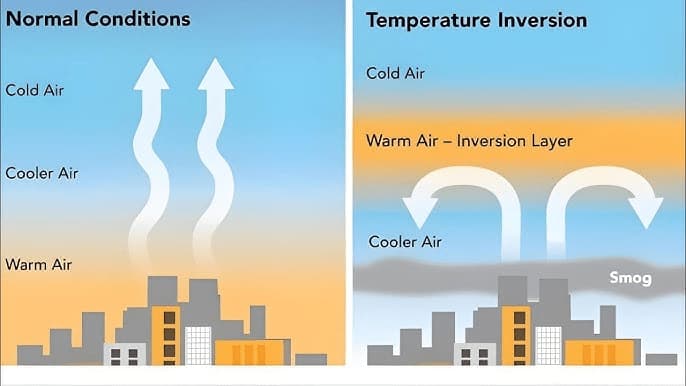Context: Stubble burning is not just a result of farmers’ apathy but a systemic outcome of distorted marketing systems and neo-liberal governance.
Factors Contributing to Pollution in Northern India
Every winter, the Indo-Gangetic Plains experience severe air pollution, enveloping the region in a thick layer of smog. Several environmental and human-induced factors play a role in this recurring crisis. Two major contributors are:
1. Temperature Inversion
During late autumn and winter, the withdrawal of monsoon winds and the drop in temperature create conditions for temperature inversion—a phenomenon where a layer of warm air settles above cooler air near the ground.
This warm layer acts as a lid, trapping pollutants such as:
Vehicular emissions
Industrial smoke
Construction dust
Suspended particulate matter (PM2.5 and PM10)
Since vertical air movement is restricted, pollutants accumulate near the surface, leading to the formation of a dense, persistent smog layer.
2. Stubble Burning in Punjab, Haryana, and Western UP
Post harvest, farmers burn leftover crop residue (stubble) to clear fields quickly for the next sowing season, especially in Punjab and Haryana.
This practice emits large amounts of particulate matter, carbon monoxide, and other toxic gases, which get trapped due to temperature inversion.
With prevailing northwesterly winds, smoke travels eastward, severely impacting air quality in Delhi and NCR regions.

2. Stubble Burning:
- Farmers in Punjab, Haryana, Rajasthan and Uttar Pradesh rely on stubble burning as a cost-effective and time-saving method to clear paddy residue before sowing Rabi wheat.
- As per a 2023 study by IIT Kanpur, IIT Delhi, TERI, and Airshed, stubble burning contributed an average of 22% to air pollution levels between mid-October and end-November 2022, with peak contributions reaching 35%. These findings are consistent with previous estimates ranging from 20% to 40%, underscoring the recurring and significant role of agricultural residue burning in deteriorating air quality.
Complex Issue of Stubble Burning
Although often viewed as a law-and-order issue or individual farmer negligence, recent studies indicate that this is a systemic outcome of distorted marketing systems and neo-liberal governance.
- Distorted Agricultural Incentives: Preferential procurement of wheat and rice under Minimum Support Price, indirectly promotes monocropping and discourages crop diversification. The narrow crop choices reduce flexibility, compelling farmers to use quick and low-cost methods like stubble burning to prepare for the next sowing cycle.
- Issues in APMCs and Intermediary dependence: The agricultural marketing system is dominated by middlemen (arhtiyas), who exercise control over pricing, credit access, and market connectivity. Farmers are often forced to sell at low prices, leading to chronic indebtedness and financial stress. Low crop prices → low income → less ability to afford clean alternatives → more stubble burning.
- Stagnant MSP rates (E.g., wheat prices rose only 5% over a decade) fail to cover rising cultivation costs, including labour and equipment.
- Neo-liberal Governance and ‘Governmentality’: Drawing from Michel Foucault’s concept of ‘governmentality’, the IIM Amritsar study highlights that the state nudges farmers toward self-regulation without adequate institutional support. On one hand, farmers are penalised for stubble burning, while on the other, the state continues to push for higher grain production to meet food security goals. This contradictory stance fosters sub-optimal behaviours like stubble burning as coping mechanisms within a broken system.
Hence, the state and market forces create a cycle of marginalisation, pushing farmers toward stubble burning as a survival tactic.
Remedial Measures
- Market Development for Stubble-Based Products: Focus on developing a market for stubble and stubble-based products, such as fodder, energy products like pellets and packaging materials, aimed to boost farmers’ income, while simultaneously addressing climate change challenges.
- Policy and Market intervention: Currently, there is a significant lack of an efficient market mechanism for farm-waste, underscoring the need for policy and market interventions to bridge this gap.
- Fair prices for Farmers: Ensuring that farmers receive fair prices for their produce by addressing existing inefficiencies within the market system. Digitise procurement platforms to reduce intermediary exploitation.
- Addressing Aspirational consumption: Recognise the role of aspirational consumption in exacerbating farm indebtedness. Socio-cultural organisations, including religious groups, could play a role in de-marketing non-essential aspirational consumption.
.
